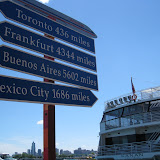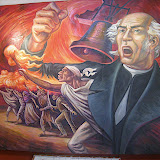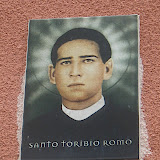Editor's note: I cannot possibly describe the fullness of our experience of last few days. But this is my attempt to try.
San JuanI will never forget my first trip to San Juan de Los Lagos – mainly because of how we arrived. We walked for four hours to get there, following pilgrims along the side of the highway under a hot afternoon sun in the semi-desert of West-Central Mexico. Pilgrims on the road: this is how I was introduced to Our Lady of the Migrants, “Chris’s girl,”
La Virgen de San Juan de Los Lagos.
I accompanied Chris to San Juan twice in our last week in Los Altos. The first time, on Tuesday, I mainly went for the tamales and ended up being swept up in a whirlwind adventure with one of San Juan’s most colorful characters. (Later I discovered our tour guide depicted in a painted mural in the municipal building. That’s right. He’s so famous in San Juan that he’s in the mural. Seriously.) And then the second time, on Thursday, I was privileged to accompany Chris as she said her last goodbyes to
la Virgencita.
I was supposed to be a research assistant during this leg of the trip, a role I haven’t exactly filled all that well. Appropriately enough, then, Chris decided to put me to work on her last day. We went into the archives of the parish church (a smaller church for locals, distinct from the virgen’s Basilica). Entry into these nationally-certified archives involves a very simple procedure: Chris smiles hello to the church secretary, who waves her on distractedly. Chris briefly explains who I am, but nobody cares. This is, Chris tells me, a very different procedure from the bureaucratic monster of the National Archives in Mexico City, where gloves, a face mask, and most of all certified credentials and identification are a must.
Our goal for the day, Chris told me, was to count all of the marriage records between 1957 and 1972. She had already taken oodles of data from these records, but did not yet have an accurate count of exactly how many there were. Given the organization of these records, this task involved counting our way through 80 heavily hardbound books. Chris figured we could do this in about 2 hours. An incredulous look washed over my face, but I quickly rubbed it away: Today, as they say in Mexico markets, I am
a sus ordenes – at your service.
We flipped through page after yellowing page, sometimes moving quickly, sometimes very slowly, depending on the quality of organization for each set of records. As lunchtime neared, we realized we weren’t going to finish on time. The parish closes for lunch at 2pm, and besides, Chris had an appointment for lunch, a goodbye meal with one of her local contacts. We would have to return later in the afternoon, after the parish re-opened two-and-a-half hours later.
(That’s right: Two-and-a-half hours for lunch. Now, it’s the main meal of the day and you probably won’t eat go home from work for the evening meal until 8 or 9 pm, so it all makes sense, but still: Subway used to give me fifteen minutes for a lunch break. Fifteen minutes versus two-and-a-half hours. I like Mexico better.)
While Chris dined with her
compañera for the last time, I grabbed some food at a grocery store and wandered around San Juan’s markets. It’s funny: Every previous time I’ve visited these markets I’ve barely given them a second look. It always seemed like there would be another time, yet now… now I have no time. I avoided the rosaries and virgencita dolls, which we already have enough of, but was drawn in by the soccer jerseys, which we… ok, which we also have enough of. But now I discovered that amid the cheap knock-offs were some really high quality jerseys. I admired them longingly. (My future internship supervisor asked me how Mexico had changed me. Does “I became a die-hard soccer fan” count?)
After the long lunch break I waited for Chris at the archives, and then we went back in for a second round. I told Chris about the soccer jerseys. She promised to buy me one for my birthday when we were done in the archives. Suddenly I moved twice as fast as I had in the morning… We finished our counting, said goodbye to the parish secretary for the last time, and went out into the streets of San Juan.
I told Chris I still hadn’t seen the murals in the municipal building up-close, so we stopped to see them before we left. They were, I was surprised to find, amazing, one of the best murals in the country right here in a public building that I’d walked by dozens of times without even thinking about it. In the mural, the Virgen of San Juan was front and center, of course, but the artist presented her in a way I’d never thought about her – or rather, in a way I’d forgotten to think about her in the midst of all my theological wrestling.
There she was, held up by two local people, depicted in a golden dress filled with the outlines of dozens of human faces. Behind her was the map-like shape of the country of Mexico, full of people coming from every direction to San Juan de Los Lagos, where a mother and daughter were planting a tree in the center of town, in the shade of the basilica. Here in this place, the mural seemed to say, people are brought together. They bring their sick, their weak, their little ones, in the hope that maybe, just maybe, here, in this place, where they are all gathering together, the ones they love will be healed, the ones they love will be made whole.
Before we went to the bus station, we stopped in the basilica to say goodbye to the virgen. We stood for a few moments in silence as the priest spoke the words of the afternoon mass, and then Chris turned to me. “Ok,” she whispered. “I’m ready.” And then we left.
Lagos de MorenoI woke up on Friday, our last day in Lagos, feeling great. It was the end of a strange spring, a time in my life that was likely never to be repeated or even imitated, and the goodbye was certain to be bittersweet. But at first I only felt sweetness, a gratitude for this time, a happiness at having been alive in this place for these four months.
I went out for my last run in the park, and pounded the dirt with my tennis shoes for nearly an hour. I ate breakfast, and went to pick up the laundry. We packed our things, and our suitcases slowly filled up. Luis, our landlord, stopped by to show the apartment to some prospective tenants. He promised to pick us up the next morning – at an absurdly early hour – to take us and our things to the bus station. And then we packed some more.
We went to lunch at our favorite torta place, and ordered our usuals, our two delicious meals combined costing us less than a lone Big Mac would back home. We took a long walk, looping around our favorite old haunts – the Templo de Merced, the Rinconada de Capuchinas, the central plaza. We walked up Calvario hill and gazed out at the landscape for an hour or more, remembering the times we’ve had here.
They haven’t been easy times, not by a long shot. I’ve struggled to figure out what to do with infinite free time that sometimes seemed to stretch out endlessly before me. Chris left the library behind and struggled to do her work by a method, oral history, that she’d never tried before, a method that called for skills she was honing for the first time in her life. Both of us struggled to figure out how to live in a context different from any we’d experienced before. This place, Los Altos de Jalisco, was as different from Guadalajara and Mexico City as Mexico is from the United States. We had essentially started our journey all over again when we moved here in March. We had to figure everything out again from scratch; we had to start again.
And yet, and yet. This was the place where it happened, all the good and all the bad. This was the place where we struggled, where we learned, where we grew. We had good days and bad days, days that felt wasted and days so filled with good things we could hardly believe they all really happened. All of it here, in this place. We are ready to move on, ready for the future. But this place, after all that has happened here, will always be a part of who we are.
We went back home to finish up our packing and then went out into a Lagos evening for the last time. Before I joined Chris at the coffee shop, however, I wanted to stop at my barbershop one more time. I did need my hair cut, but, truth be told, I also wanted to say goodbye to my barber, who had always been friendly to me.
I walked in, feeling awkward as ever about my Spanish; somehow all my language learning seems to evaporate the moment I walk through the doorway of that place. But my barber was happy to see me anyway. I told him we were leaving in the morning. “Oh,” he said, “that’s too bad.” The radio was playing music broadcast from the local cultural center, Casa Serrano. The barber pointed this out, and then was shocked to discover that I had never visited it. He starts quizzing me about Lagos culture. “Do you know the writers from Lagos?” I name Mariano Azuela, author of
Los de Abajo, the most famous novel of the Mexican Revolution. “
Si, y que mas? – Yes, and who else?” Um…I name Juan Rulfo, another famous author from Jalisco, but of course this is the wrong answer because Juan Rulfo is not from Lagos. I am in for a lesson, I can see that already…
My barber names four other authors, and gives me the titles of their books. Then he moves on the visual arts, and shows me a magazine with the work of a Lagos artist inside. “This artist lives just down the street,” he tells me. Then he goes in a new direction: “Did you know that I am also an artist? I meet regularly with other artists in town, we have a little artist’s collective.” I look around at the paintings on the wall – which are, quite frankly, really good. “Are these yours?”
Si, he says, of course! He finishes cutting my hair and asks if I’d like to see more of his work. Sure, I say. He takes me upstairs, behind the barbershop, to his tiny workshop.
There must be a hundred paintings in here, some huge and covering the entire wall, some small and finely detailed. They are done in a variety of styles and with a variety of materials. Many of them are of local places and people, Lagos landmarks and Lagos characters. All of them are excellently rendered, professional, clearly the work of someone who knows what he is doing.
“I am in a group with other Lagos artists,” he tells me again. “Some of them paint, others sculpt, some are musicians and some are writers.” I nod, but he isn’t satisfied that I understand. “We have so much culture here in Lagos! There are many artists here, and lots of culture.” And then I get it. Here in the upstairs artist studio of a local barber I realize – no, I am told flat-out – that after four long months I still haven’t seen the half of this place. There is so much I still don’t know about these people.
I leave feeling amazed. Who goes to get their hair cut and ends up seeing the barber’s personal art studio? I find Chris at the coffee shop. We think about saying a long goodbye to the baristas, but they’re busy with the Friday night rush, so we suffice with an “
hasta luego – see you later” – they respond with the familiar “
¡que te vaya muy bien! – may you travel well!” – and we walk out of there for the last time.
On the way home, I insist that we stop into the Super Fruteria produce store to say goodbye to its manager, who has always been so incredibly friendly to us. Luckily, it is still open, and he is there. He gives us a big smile, as always, and greets us by name: “
¡Hola Cristina! Hola Mateo!” We tell him we are leaving, and his smile disappears. “
Ay no, already?” We chat for a few moments about Chicago, where, we discover for the first time, he has family. The things we don’t know about the people here…
Then he asks us the question everyone seems to be asking us when we say goodbye: “When will you be back to visit?” Someday, we say, but not for a few years. “But don’t you have any friends here to visit?” he asks. We look at each other and smile sheepishly. We’ve met lots of friendly people here, to be sure, many of whom know our faces and some of whom even know us by name. But friends? Not really, we think, and shake our heads no. “Well,” he says, “I hope you come back soon.
Tiene un amigo aqui. You have a friend here.” He smiles a great big smile, shakes both our hands, and tells us to travel well.
As we go to bed in our mattress on the floor for the last time, I find myself unable to sleep, overwhelmed by these last few hours in Lagos. Chris and I have moved so many times in the last few years, from one state to another, from one country to another, from town to city to city to town. But, with the exception of saying goodbye to our friends at seminary, this is the first time that we have had to say goodbye to so many people, people we will probably never see again. It is a realization that says something about our time here, something I have only realized now, at the end of things.
In the morning, while it is still dark, I take one last look at the view from our rooftop. I say a prayer of thanksgiving, and then it is time to go. Luis picks us up in his truck and drives us to the bus station. We shake his hand and thank him for everything, and then we are off and on our way, our time in Jalisco finally come to an end.

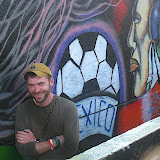
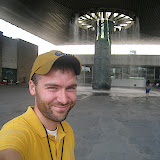
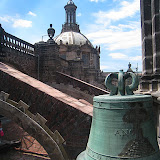
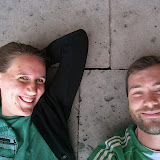
 (Above: In our beloved coffee shop for the last time.)
(Above: In our beloved coffee shop for the last time.)